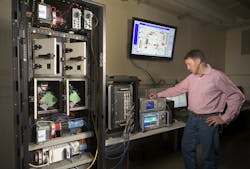Free Advice From NIST on Going Wireless
The “smart factory,” also known as “the fourth Industrial Revolution,” will be full of networked machinery under the control of computers that monitor and direct processes, while machines communicate with each other and managers at high speeds and the factory itself decides how to optimize and facilitate production. Or at least, that’s the goal. But it will take reliable wireless communications to make it all happen, according to the National Institute of Standards and Technology (NIST). To make smart factories a reality, or at least speed the process, NIST has published its Guide to Industrial Wireless Systems Deployments, a set of guidelines to help users select the best wireless system for any industrial environment, design the setup to make it work and deploy it, and then ensure the network performs as needed.
By eliminating physical connections such as wires and cables from a facility’s communication network, wireless technology offers many factories a means to run their entire operations more efficiently and productively, and at less cost. However, concerns about reliability, integrity, and security have hampered the adoption and use of industrial wireless, especially when wireless communication can often be disrupted by obstructions and interference in harsh industrial settings.
NIST has working with private-sector collaborators and standards organizations to overcome these obstacles and make industrial wireless communication the first choice for factories. As part of that effort, in March of last year NIST and the Institute of Electrical and Electronics Engineers (IEEE) organized a group of experts on wireless communications from government, industry, and academia to develop “a succinct-yet-comprehensive, easy-to-use reference guide and best practices manual for anyone, from control engineers to factory managers, to add a robust, safe, reliable, and secure wireless system into industrial landscapes,” says Rick Candell, an electronics engineer in NIST’s Engineering Laboratory.
Candell said that guide walks users clearly and thoroughly through every step needed to get the best wireless fit for any specific operation. The document provides valuable background, strategies, and tools that help users:
- Understand wireless technologies and networking basics, including a glossary of terms, a review of radio frequency (RF) considerations, and a list of technical challenges (such as latency, the time it takes for data to go from source to target);
- Make a business case for wireless;
- Break down the components of a complete wireless lifecycle, from defining objectives to deploying and monitoring the final system;
- Use wireless to enhance factory safety;
- Protect and secure a wireless network;
- Learn about best wireless practices such as optimal antenna placement, getting around obstructions and interference problems, and preventing redundant signal paths; and
- Follow a set of easy-to-use checklists for each element of the wireless deployment lifecycle, including evaluating the factory and its operations for communications needs, comparing available technologies, and methodically designing and deploying a working wireless system.
The guide also contains a series of best-practice case studies showing what strategies can be used to improve wireless communications in different factory situations.
“For example, one scenario looks at a common but often overlooked problem when using wireless communications: dealing with the RF interference that may arise from microwave ovens, Bluetooth devices, and other nonoperational items personnel use,” Candell says. “The guide explains how to identify the sources of such interference, measure how they affect factory operations, and then use the data to choose the most appropriate solution from those described in the text.”
Another case study described by the guide shows how to properly deployed wireless could prevent a hazardous work environment. “Wireless gas sensors can monitor the accumulation of poisonous or combustible gases in a work setting but only if all of the signal transmission and propagation challenges in that area are considered,” Candell explains. “We use the example of a welder in a confined space whose torch is producing carbon monoxide gas, and show how successful, continuous monitoring depends on critical factors such as antenna placement and using several sensors in case one fails.”
Candell says future NIST guides will address more advanced communications scenarios, such as wireless technologies for controlling a factory’s mobile and collaborative robots.

